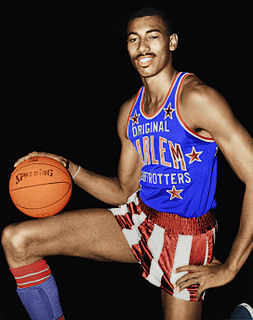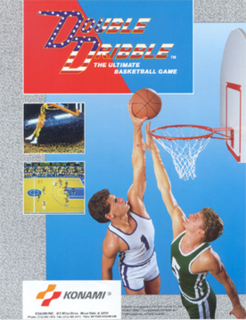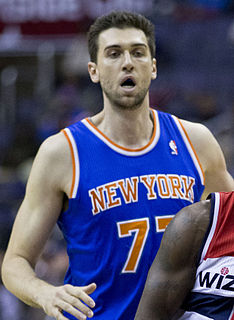Related Research Articles

Basketball, colloquially referred to as hoops, is a team sport in which two teams, most commonly of five players each, opposing one another on a rectangular court, compete with the primary objective of shooting a basketball through the defender's hoop while preventing the opposing team from shooting through their own hoop. A field goal is worth two points, unless made from behind the three-point line, when it is worth three. After a foul, timed play stops and the player fouled or designated to shoot a technical foul is given one, two or three one-point free throws. The team with the most points at the end of the game wins, but if regulation play expires with the score tied, an additional period of play (overtime) is mandated.

Wilton Norman Chamberlain was an American professional basketball player who played as a center and is considered one of the greatest players in history. He played for the Philadelphia/San Francisco Warriors, the Philadelphia 76ers, and the Los Angeles Lakers of the National Basketball Association (NBA). He played for the University of Kansas and also for the Harlem Globetrotters before playing in the NBA. Chamberlain stood 7 ft 1 in (2.16 m) tall, and weighed 250 pounds (110 kg) as a rookie before bulking up to 275 and eventually to over 300 pounds (140 kg) with the Lakers.

Hakeem Abdul Olajuwon, formerly Akeem Olajuwon, is a Nigerian-American former professional basketball player. He is considered to be one of the greatest basketball players of all time. He was nicknamed "The Dream" during his basketball career after he dunked so effortlessly that his college coach said it "looked like a dream." From 1984 to 2002, he played the center position in the National Basketball Association (NBA) for the Houston Rockets and the Toronto Raptors. He led the Rockets to back-to-back NBA championships in 1994 and 1995. In 2008, he was inducted into the Basketball Hall of Fame, and in 2016, he was inducted into the FIBA Hall of Fame.

A box score is a structured summary of the results from a sport competition. The box score lists the game score as well as individual and team achievements in the game.

Artis Gilmore is an American former professional basketball player who played in the American Basketball Association (ABA) and National Basketball Association (NBA). Gilmore was inducted into the Naismith Memorial Basketball Hall of Fame on August 12, 2011.

Andris Biedriņš is a Latvian former professional basketball player. He was drafted by the Golden State Warriors with the 11th overall pick in the 2004 NBA draft.

The rules of basketball are the rules and regulations that govern the play, officiating, equipment and procedures of basketball. While many of the basic rules are uniform throughout the world, variations do exist. Most leagues or governing bodies in North America, the most important of which are the National Basketball Association and NCAA, formulate their own rules. In addition, the Technical Commission of the International Basketball Federation (FIBA) determines rules for international play; most leagues outside North America use the complete FIBA ruleset.
Basketball moves are generally individual actions used by players in basketball to pass by defenders to gain access to the basket or to get a clean pass to a teammate to score a two pointer or three pointer.

Daniel Anthony Fortson is an American former professional basketball player. He played the power forward and center position in the National Basketball Association (NBA) from 1997 to 2007.

Double Dribble, known in Japan as Exciting Basket, is a basketball arcade game developed and released in 1986 by Konami. It was the second basketball arcade game by Konami, following Super Basketball. Much of the game's popularity came from its animation sequences showing basketball players performing slam dunks, as well as "The Star-Spangled Banner" theme during attract mode, which was the first arcade game to feature the national anthem. These were uncommon in video games at the time of Double Dribble's release. While successful in the arcades, the game became and remained popular and remembered when it was ported to the Nintendo Entertainment System in 1987.
In basketball, traveling is a violation of the rules that occurs when a player holding the ball moves one or both their feet illegally. Traveling is also called, predominantly in a streetball game, "walking" or "steps". If the pivot foot is lifted, a pass or try for made basket must be made before the pivot foot is replaced to the floor. In the NBA and FIBA, you are also given a "gather step".
Advanced statistics in basketball refers to analyzing basketball statistics through objective evidence. APBRmetrics is a cousin to the study of baseball statistics, known as sabermetrics, and similarly takes its name from the acronym APBR, which stands for the Association for Professional Basketball Research.

Andrea Bargnani is an Italian former professional basketball player. The 7 ft 0 in (213 cm) power forward-center played for Benetton Treviso in the Italian LBA and the EuroLeague before being selected first overall in the 2006 NBA draft by the Toronto Raptors. He spent 10 seasons in the NBA before ending his career with a stint in Spain during the 2016–17 season.

This glossary of basketball terms is a list of definitions of terms used in the game of basketball. Like any other major sport, basketball features its own extensive vocabulary of unique words and phrases used by players, coaches, sports journalists, commentators, and fans.
Statistics in basketball are kept to evaluate a player's or a team's performance.
The 1972 NBA World Championship Series was the championship round played at the conclusion of the 1971–72 National Basketball Association (NBA) season. The Western Conference champion Los Angeles Lakers defeated the Eastern Conference champion New York Knicks in five games. The Lakers got their first NBA championship since the franchise moved to Los Angeles from Minneapolis, Minnesota. It was a rematch of the 1970 NBA Finals that the Knicks had won in a full seven-game series.
Basketball is a ball game and team sport in which two teams of five players try to score points by throwing or "shooting" a ball through the top of a basketball hoop while following a set of rules. Since being developed by James Naismith as a non-contact game that almost anyone can play, basketball has undergone many different rule variations, eventually evolving into the NBA-style game known today. Basketball is one of the most popular and widely viewed sports in the world.
In professional basketball, the most commonly used statistical benchmark for comparing the overall value of players is called efficiency. It is a composite basketball statistic that is derived from basic individual statistics: points, rebounds, assists, steals, blocks, turnovers and shot attempts. The efficiency stat, in theory, accounts for both a player's offensive contributions and their defensive contributions, but it is generally thought that efficiency ratings favor offense-oriented players over those who specialize in defense, as defense is difficult to quantify with currently tabulated statistics.
SportVU is a camera system hung from the rafters that collects data 25 times per second and follows the ball and every player on the court. SportVU provides in-depth statistics, including real-time player and ball positioning through sophisticated software and statistical algorithms. SportVU's speed, distance, and possession data provide key insights and analysis points.
Aaron Joseph Granger is an American former professional basketball player.
References
- ↑ nba.com. Hangtime Podcast (episode 133). Accessed 2 November 2013
- ↑ "NBA announces multiyear partnership with Sportradar and Second Spectrum". NBA.com: NBA Communications. 2016-09-22. Retrieved 2019-06-13.
- ↑ "Players Shooting Efficiency". NBA Stats. Retrieved 2019-06-13.
- ↑ "Teams Drives". NBA Stats. Retrieved 2019-06-13.
- ↑ "Nylon Calculus: How Second Spectrum is redesigning the NBA". FanSided. 2018-06-28. Retrieved 2019-06-13.
- ↑ stats.nba.com. "Player Tracking", Accessed 2 November 2013
